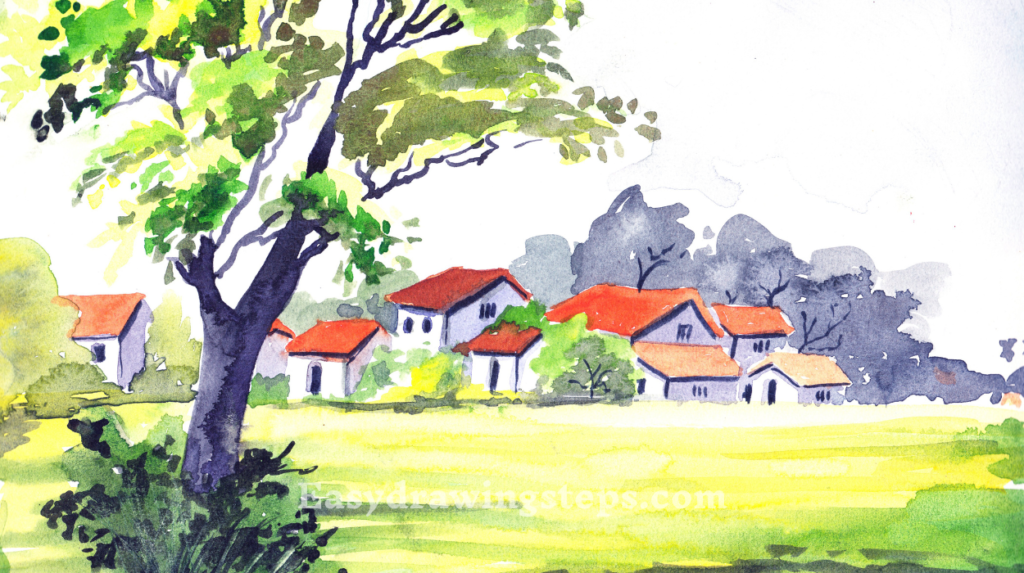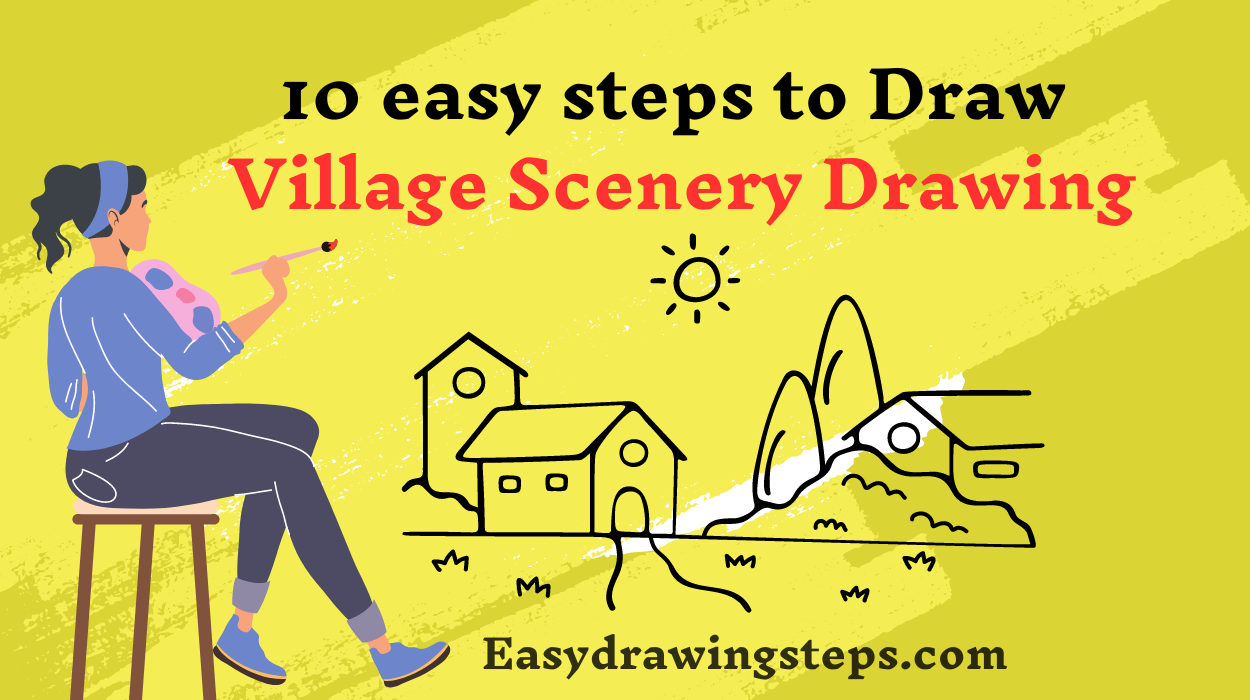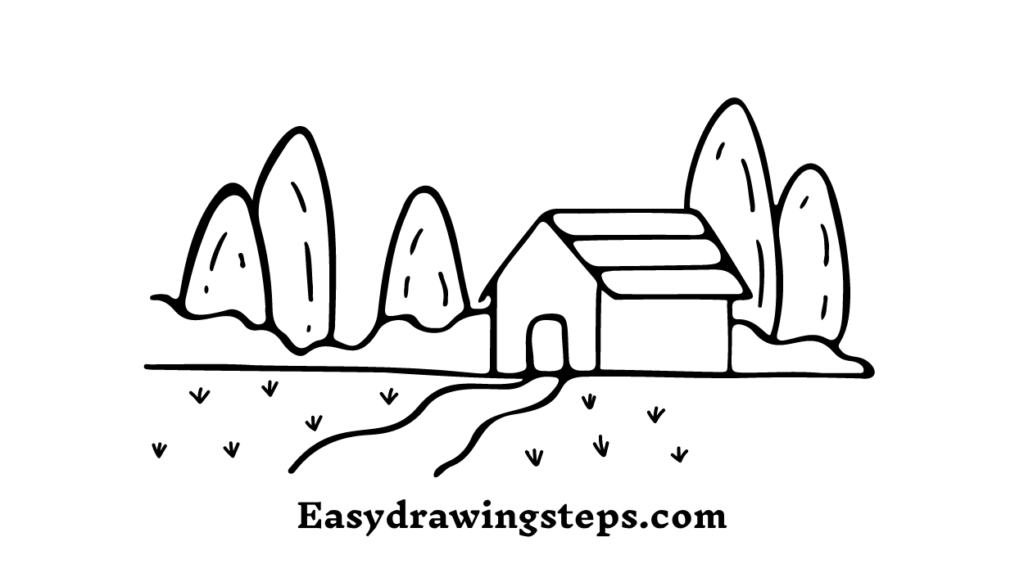
Village Scenery Drawing : Drawing a beautiful village scenery can be a delightful and fulfilling experience.
Village scenes often capture the serene and picturesque aspects of rural life, making them a favorite subject for many artists.
Follow these ten easy steps to create your own stunning village scenery drawing.
This guide is designed to make the drawing process simple and enjoyable for everyone, including kids and beginners.
Step 1: Gather Your Materials
Before you start, ensure you have all the necessary materials. You will need drawing paper, pencils (preferably HB for sketching and 2B or 4B for shading), an eraser, a sharpener, and colored pencils or watercolor paints if you plan to add color to your drawing. These materials will help you create a detailed and vibrant village scenery drawing.
Step 2: Draw the Horizon Line
Start by drawing a horizontal line across your paper. This line represents the horizon and will help you position all the elements in your drawing. The horizon line can be placed slightly above the center of the paper to allow more space for the foreground.
Also Read : 10 easy steps to draw Lion Face Drawing
Step 3: Sketch the Basic Shapes
Begin sketching the basic shapes of the village elements. Draw simple shapes to represent houses, trees, a river, and fields. Use rectangles and triangles for houses, ovals and circles for trees, and curved lines for the river. These shapes will serve as the foundation for your drawing.

Step 4: Outline the Houses
Refine the shapes of the houses. Add details like roofs, windows, doors, and chimneys. Make sure the houses are proportional and positioned naturally within the scene. Adding these details will make your village look more realistic and charming.
Also Read : 10 easy steps to draw Mermaid Drawing
Step 5: Draw the Trees and Foliage
Outline the shapes of the trees and add details like branches and leaves. You can draw a mix of different types of trees to make the scenery more diverse. Use curved and wavy lines to represent the foliage and give the trees a natural look.

Step 6: Add the River and Fields
Draw the river flowing through the village. Use curved lines to depict the riverbanks and add small details like rocks or waves to give it a more dynamic appearance. Sketch the fields and farmlands around the village using horizontal and vertical lines to represent the rows of crops.
Also Read : 10 easy steps to draw Rukia Kuchiki Drawing
Step 7: Include Additional Elements
Enhance the scene by adding more elements such as a small bridge over the river, pathways, fences, and farm animals. These additional details will bring your village scenery to life and make it more interesting.
Step 8: Refine the Drawing
Refine the entire drawing by going over the outlines and adding finer details. Erase any unnecessary guidelines and smooth out the lines to make the drawing cleaner and more defined. Focus on making the shapes and lines of the houses, trees, river, and other elements more accurate and detailed.
Also Read : 10 easy steps to draw Hulk Drawing
Step 9: Shade and Highlight
To give your village scenery drawing a three-dimensional effect, add shading and highlights. Use a 2B or 4B pencil to add shadows to the areas where the light doesn’t hit, such as under the eaves of the houses, the side of the trees, and the riverbanks. Blend the shading with a blending stump or your finger to create smooth transitions between light and dark areas. Use an eraser to add highlights on the roofs, tree tops, and water surface, enhancing the depth and dimension of the drawing.
Step 10: Color Your Drawing
Finally, add color to your village scenery drawing using colored pencils or watercolor paints. For a more realistic look, use natural colors like green for the fields and trees, blue for the river, and earthy tones for the houses and pathways. Layer the colors and blend them smoothly to achieve a polished look. Adding color will make your drawing vibrant and more lifelike.
Other Village Scenery Drawing Ideas
- Beautiful village scenery drawing: This refers to a drawing that captures the picturesque and serene aspects of a village scene. The focus is on creating a visually appealing and charming representation of rural life.
- Easy village scenery drawing: This implies a drawing process that is straightforward and simple, suitable for beginners or kids. The steps are designed to be easy to follow, ensuring that anyone can create a lovely village scenery drawing without much difficulty.
- Village scenery drawing easy: Similar to the above, this emphasizes the simplicity and ease of creating the drawing. The goal is to make the process accessible to everyone, regardless of their skill level.
- Village scenery drawing watercolor: This involves using watercolor paints to add color to the village scenery drawing. Watercolor techniques can enhance the beauty and depth of the drawing, making it more vibrant and dynamic.
Creating a village scenery drawing is a fun and engaging activity, especially with these simplified steps. This guide makes the process easy for everyone, including kids and beginners. By starting with basic shapes and gradually adding details, even novices can create a detailed and accurate village scene.
Using pencils for the initial sketch allows for easy corrections and refinements, while shading with different pencil grades adds depth and dimension. Coloring the drawing with pencils or watercolors brings the final touch, making the artwork vibrant and lifelike. Enjoy the process and happy drawing!
FAQ
What materials do I need to draw a village scenery?
To draw a village scenery, you will need the following materials: drawing paper, pencils (preferably HB for sketching and 2B or 4B for shading), an eraser, a sharpener, and colored pencils or watercolor paints if you plan to add color to your drawing. These materials will help you create a detailed and vibrant village scenery drawing.
How can beginners create an easy village scenery drawing?
Beginners can create an easy village scenery drawing by following a step-by-step approach. Start with simple shapes like rectangles for houses and ovals for trees. Use curved lines to represent natural elements like rivers and fields. Gradually add details such as windows, doors, and leaves. Keeping the drawing simple and focusing on basic shapes will make it more manageable for beginners.
What are the key elements to include in a village scenery drawing?
Key elements to include in a village scenery drawing are houses, trees, a river or pond, fields, and additional features like pathways, fences, and farm animals. These elements help capture the essence of rural life and make the scenery more picturesque and realistic. Including a variety of elements will add depth and interest to your drawing.
How can I add depth and dimension to my village scenery drawing?
To add depth and dimension to your village scenery drawing, use shading and highlights. Identify the light source in your drawing and add shadows to areas where the light doesn’t hit, such as under the eaves of houses, on the sides of trees, and along the riverbanks. Blend the shading smoothly to create transitions between light and dark areas. Use an eraser to add highlights on the roofs, tree tops, and water surface to enhance the three-dimensional effect.
What techniques can I use to color my village scenery drawing?
You can use colored pencils or watercolor paints to color your village scenery drawing. For a more realistic look, use natural colors like green for the fields and trees, blue for the river, and earthy tones for the houses and pathways. Layer the colors and blend them smoothly to achieve a polished look. Watercolor techniques can add a dynamic and vibrant quality to your drawing, making it more lifelike and engaging. Use light washes for large areas and more detailed brushwork for smaller elements.



2 thoughts on “10 easy steps to draw Village Scenery Drawing”